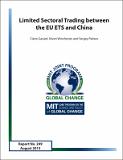Limited Sectoral Trading between the EU ETS and China
Author(s)
Gavard, Claire; Winchester, Niven; Paltsev, Sergey
Downloadmain article (748.8Kb)
Metadata
Show full item recordAbstract
In the negotiations of the United Nations Framework Convention on Climate Change (UNFCCC), new market mechanisms are proposed to involve Non-Annex I countries in the carbon markets developed by Annex I countries, beyond their current involvement through the Clean Development Mechanism (CDM). Sectoral trading is one such mechanism. It would consist of coupling one economic sector of a Non-Annex I country, e.g., the Chinese electricity sector, with the carbon market of some Annex I countries, e.g., the European Union Emission Trading Scheme (EU ETS). Previous research analyzed the potential impacts of such a mechanism and concluded that a limit would likely be set on the amount of carbon permits that could be imported from the non-Annex I country to the Annex I carbon market, should such a mechanism come into effect. This paper analyzes the impact of limited trading in carbon permits between the EU ETS and Chinese electricity sector when the latter is constrained by a 10% emissions reduction target below business as usual by 2030. The limit on the amount of Chinese carbon permits that could be sold into the European carbon market is modeled through the introduction of a trade certificate system. The analysis employs the MIT Emissions Prediction and Policy Analysis (EPPA) model and takes into account the banking–borrowing of allowances and the inclusion of aviation emissions in the EU ETS. We find that if the amount of permits that can be imported from China to Europe is 10% of the total amount of European allowances, the European carbon price decreases by 34%, while it decreases by 74 % when sectoral trading is not limited. As a consequence, limited sectoral trading does not reverse the changes initiated in the European electricity sector as much as unlimited sectoral trading would. We also observe that international leakage and leakage to non-electricity sectors in China are lower under limited sectoral trading, thus achieving more emissions reductions at the aggregate level. Finally, we find that, if China can capture the rents due to the limit on sectoral trading, it is possible to find a limit that makes both regions better off relative to when there is no international trade in carbon permits.
Date issued
2013-08-21Publisher
MIT Joint Program
Citation
Report 249
Series/Report no.
MIT Joint Program Report Series;Report 249